Chefs give new meaning to haute cuisine : Michelin restaurants serve up classy meals on low-cost flights
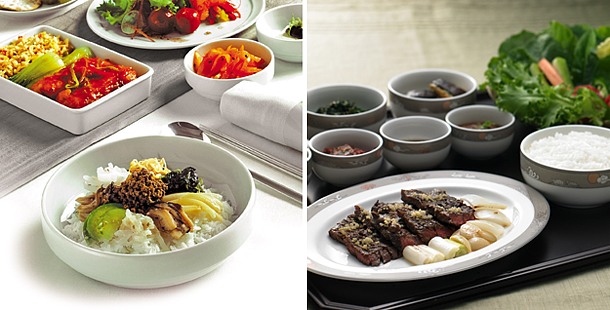
Left, Korean Air’s famous bibimbap along with steak. Around 60 percent of its passengers opt for bibimbap, according to a source from the airline. Right, ssambap provided to first-class passengers at Asiana Airlines. [KOREAN AIR, ASIANA AIRLINES]
But amid the rising international popularity of Korean food, airlines have begun to compete to provide more haute Korean cuisine on more air routes. While in-flight meals developed by Michelin star chefs are being provided to economy class passengers, Korean dishes are being distributed on routes outside Korea.
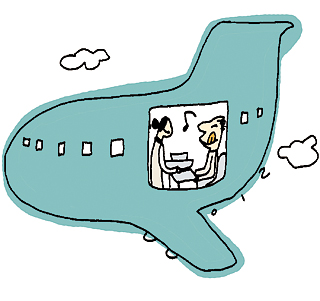
[KANG IL-GOO]
Ever since, Korea’s two largest flag carriers have continued to beef up the quality of their in-flight meals. Korean Air, for example, uses beef and chicken raised at its ranch near Mt. Halla on Jeju Island, while Asiana Airlines works with the Institute of Korean Royal Cuisine and Italian restaurant La Cucina for its meals.
“Korean passengers expect the quality of in-flight service to be as high as Korean Air and Asiana Airlines, whichever airline they fly on,” said Lee Mun-jeong from Air France-KLM. “Ever since the two airlines began providing hansik (Korean food), the number of passengers seeking hansik has jumped, forcing even foreign airlines to make changes.”
Foreign airlines that used to simply only serve bibimbap as their in-flight Korean meal recently began to conduct experiments on diversifying the menus. Singapore Airlines, for example, formed a partnership with the Michelin-starred restaurant Jung Sik Dang.
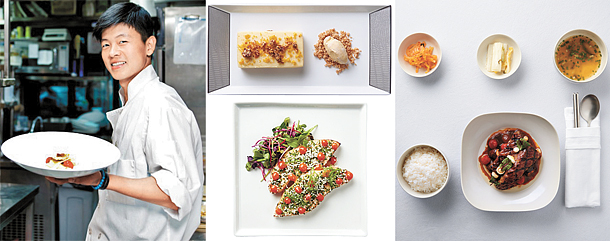
Chef Yim Jung-sik from the Michelin-starred Jung Sik Dang has designed a menu for Singapore Airlines featuring beef ribs, grilled swordfish and corn mousse cake. [SINGAPORE AIRLINES]
“Even before Michelin was announced [last year], we began negotiating with Jung Sik Dang to cater Korean food on the plane,” said a source from Singapore Airlines. “We are receiving advice from internationally renowned chefs like Gordon Ramsay, and are providing prestigious food like kaiseki [a traditional, multi-course Japanese meal] from the [three-Micheline-starred] Kikunoi in Kyoto. We are putting particular effort into the quality of in-flight meals.”
Then what menus has chef Yim developed for Singapore Airlines’ passengers? First-class passengers are served a four-course menu. The main dish menu consists of steam-cooked black cod, grilled lobster and maesaengi (seaweed rice porridge). The first-class passengers are also served healthy desserts like corn mousse cake. Business-class passengers can enjoy a three-course menu. The main dish menu is braised beef ribs, pork belly with assorted vegetables or grilled tuna bibimbap. Economy-class passengers have the option of bibimbap with either beef or pork. Instead of the usual gochujang (Korean red pepper paste), perilla oil is used as the main sauce.
Premium meals to lure passengers
In-flight meals on flights from Korea are prepared at Incheon International Airport by two specialized catering enterprises: Korean Airlines and LSG Sky Chefs.
Currently, all airlines that take off from Korea serve meals from the two firms, meaning even the menus developed by chefs from Michelin-starred restaurants are made based on the recipes provided by the catering services.
Those airliners that actively promote in-flight meals under the title of chefs from Michelin-starred restaurants often drop by the catering firms to check on the quality of food and change menus once every two to three months.
“Though in-flight meals provided to economy class passengers have been generally standardized, menus developed for business and first-class passengers are continuously being developed,” said Kim Gi-jin from LSG Sky Chefs. “This is an investment to lure loyal customers amid the growing market share of low-cost carriers.”
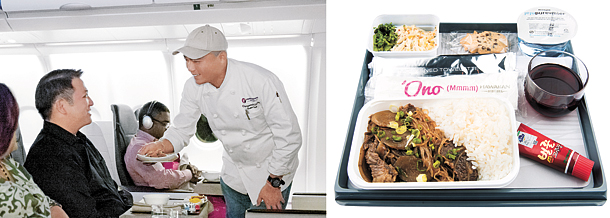
Left: Chef Jung Chan-wook serves a passenger on a Hawaiian Airlines flight. Right: Steamed beef and burdock roots by Jung. [HAWAIIAN AIRLINES]
Based on his experience studying in Hawaii, he serves various fusion dishes. Menus include steamed beef and burdock roots, macadamia nut cookies and Japanese miso soup.
On Jan. 6, Jung boarded a Hawaiian Airlines flight to hold a special event, where he personally cooked for passengers.
“Amid the rising popularity and interest in star chefs in Korea, we decided to form a partnership with Jung Chan-wook, who has close ties with Hawaii,” said Yoo soo-jin from Hawaiian Airlines. “Reservations for the flight Chef Jung was going to board closed very quickly thanks to his popularity.”
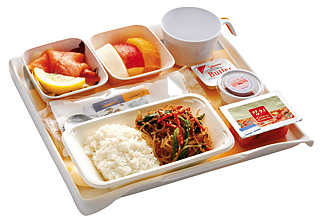
Millennium Seoul Hilton’s beef japchae (stir-fried noodles) served on a Lufthansa flight. [LUFTHANSA AIRLINE]
Foreign airlines’ efforts to form partnership with Korean restaurants began ten years ago.
KLM Royal Dutch Airlines signed a partnership with a Korean restaurant, Yongsusan, in 2007, which created buzz for introducing high-quality cuisine from Goryeo Dynasty (918-1392) as part of its in-flight meals. The Dutch airline changed its partner to a different Korean restaurant, Samcheonggak, in 2014.
“In order to find an appropriate Korean restaurant, we searched for and tried food from myriad Korean restaurants,” said Kim Mi-young from KLM. “Though there were a number of restaurants that serve visually appealing and fancy food, the most important factor for us was taste.”
Similarly, Germany’s Lufthansa Airline signed a contract with Millennium Seoul Hilton Hotel in 2009. Also, Air France formed a partnership with Woonsan in April 2016; business passengers traveling from Paris to Incheon can now enjoy food by Woonsan’s chef Kim Yoon-young.
“Since Korean dishes include lots of vegetables, foreign passengers can see Korean food is healthy,” said Kim, “ultimately leading them to order Korean cuisine on flights. And because their sense of taste is diminished in a pressurized cabin, Korean food, which is spicy and salty, is being well received.”
Good food isn’t just for larger airlines
Delicious airline meals that were usually only available on big airlines like Korean Air have even become available on low-cost carriers, as they have started signing partnerships with various food companies.
But instead of signing contracts with fancy restaurants, they formed partnerships with comparatively cheaper food stores or convenience stores.
Korea’s Eastar Jet signed a contract with GS Retail in 2015. The airline serves GS Retail’s lunch boxes, travel goods and daily necessities, earning the title “on-flight convenience store.” Another domestic low-cost carrier, T’Way Air, similarly signed a contract with a hand-made cake store, Jiyugaoka, located in Cheongdam-dong, southern Seoul, and sells its cakes on flight.
Even foreign low-cost carriers have begun serving delicious food on flight.
Vietnam’s VietJet Air, for example, signed a partnership with fast-food restaurant franchise Lotteria in 2015, and has been serving its rice burgers. It even flies an airplane featuring Lotteria’s logo.
Jeju Air is currently making and serving private-branded products instead of signing contracts with restaurants.
Among the exclusive food it serves, tangerine juice, horse beef jerky and black pork jerky are three of the most well-received.
BY CHOI SEUNG-PYO
[jin.minji@joongang.co.kr]
[스타일] 스타 셰프가 만든 비빔밥 … 기내식으로 주는 곳은 어디?
기내식에 한식 바람이 불고 있다. 너무 오래된 얘기 아니냐고? 맞다. 이 말이 20여 년 전부터 나왔으니 말이다. 아시아나항공이 김치를 기내에 들이고, 대한항공이 비빔밥을 처음으로 선보인 게 1990년대 얘기다. 기내식의 한식 유행은 여전하지만 훨씬 고급화하고 훨씬 더 다양한 노선에서 맛볼 수 있다는 면에선 분명 달라졌다. 서울의 미쉐린(미슐랭) 스타 셰프가 개발한 기내식을 이코노미클래스 승객에게도 주는가 하면 심지어 한국을 드나들지 않는 노선에서도 기내 테이블에 비빔밥이 오른다. 한식, 이른바 K-푸드의 위상이 높아진 데다 항공사들이 고급 서비스 경쟁에 열을 올리면서 벌어진 일이다.
한식 기내식의 역사는 사실 짧다. 아시아나항공이 95년에 김치를, 대한항공이 97년에 비빔밥을 제공하기 시작했다. 이후 대한항공은 제주 한라산 목장에서 직접 기른 쇠고기와 닭고기를 쓰고, 아시아나항공은 궁중음식연구원이나 서울의 전통 있는 이탈리안 레스토랑인 라쿠치나와 제휴를 맺는 등 고급화에 공을 들이고 있다. 한국에 취항하는 외국계 항공사도 이에 뒤질세라 기내식에 변화를 주고 있다.
에어프랑스·KLM 이문정 한국지사장은 “한국 승객은 모든 기내 서비스를 대한항공·아시아나항공 수준으로 기대한다”며 “두 항공사가 한식을 선보인 뒤로 어느 비행기를 타든 한식을 찾는 승객이 부쩍 늘었고 외국계 항공사도 이에 맞춰 기내식에 변화를 주기 시작했다”고 설명했다.
비빔밥 수준의 한식을 제공하던 외국계 항공사들은 최근 다양한 실험을 하고 있다. 미쉐린 3스타(뉴욕 정식 레스토랑 2스타, 서울 정식당 1스타)를 보유한 임정식 셰프와 제휴한 싱가포르항공이 대표적이다. 3월부터 9월까지 정식당 임정식 셰프가 개발한 기내식을 인천발 싱가포르·로스앤젤레스행 항공편에서 제공한다. 싱가포르항공 측은 “미쉐린 가이드 서울편 발표가 나기 전부터 한식 기내식 프로모션 차원에서 정식당과 협의를 시작했다”며 “고든 램지 같은 세계적인 셰프의 조언을 받고 있고, 교토 기쿠노이(미쉐린 3스타)의 가이세키 요리를 제공하는 등 기내식에 각별한 공을 들이고 있다”고 설명했다.
임정식 셰프가 개발한 메뉴는 뭘까. 이코노미·프리미엄 이코노미석 승객에게는 들기름 비빔밥을 준다. 흔한 고추장이 아니라 임 셰프가 직접 개발한 특제 소스가 나온다. 비즈니스클래스는 밤·무·느타리버섯을 곁들인 소갈비와 쌀밥을 준다. 퍼스트클래스 승객에게는 김부각을 곁들인 묵 탕평채와 고추장 뵈르블랑 소스를 곁들인 랍스터구이 등 호화 정찬을 차려준다. 당귀 푸딩, 옥수수 무스케이크 등 디저트까지 건강식으로 개발했다.
"프리미엄 기내식은 충성 고객 위한 투자”
기내식은 인천공항에 있는 전문 케이터링 업체가 만든다. 대한항공과 LSG스카이셰프가 시장을 양분하고 있다. 현재 국내에 취항하는 모든 항공사는 두 회사를 통해 기내식을 주문하고 비행기에 싣는다. 미쉐린 스타 셰프가 개발한 메뉴도 결국 케이터링 업체가 전수받은 레시피로 기내식을 만드는 셈이다. 셰프나 식당 이름을 내건 항공사는 주기적으로 케이터링 업체를 찾아가 품질을 관리하고 메뉴도 두세 달에 한 번씩 바꾸며 품질을 관리한다. 김기진 LSG스카이셰프 상무는 “일반석 승객용 기내식은 어느 정도 표준화한 반면 프리미엄 클래스(비즈니스·퍼스트클래스) 고객을 위한 기내식은 끝없이 고급화하고 있다”며 “날로 시장점유율이 커지는 저비용항공과 차별화한 서비스로 충성 고객을 잡기 위한 투자로 볼 수 있다”고 설명했다.
연예인 버금가는 인기를 누리는 스타 셰프와 손을 잡은 항공사도 있다. JTBC 요리 예능 ‘냉장고를 부탁해’로 이름을 알린 비스트로 차우기의 정창욱 오너셰프는 2016년 12월부터 하와이안항공의 기내식을 맡았다. 정씨는 하와이 유학 경험을 바탕으로 하와이 음식과 한식을 결합한 팬아시안(Pan Asian) 요리를 기내식으로 선보였다. 실곤약을 곁들인 쇠고기 우엉찜, 마카다미아너트 쿠키, 일본식 된장국 등 다른 항공사에서는 맛보기 힘든 퓨전 요리다.
1월 6일 정씨는 인천발 하와이안항공에 직접 탑승해 승객에게 음식을 내주는 ‘플라이 위드 셰프’ 이벤트도 벌였다. 유수진 하와이안항공 한국지사장은 “한국에서 미식에 대한 관심과 스타 셰프의 인기가 높아지던 중 하와이와 인연이 깊은 정창욱 셰프와 제휴를 결정했다”며 “정 셰프가 탑승하는 항공편은 일찌감치 예약이 마감되는 등 호응이 뜨거웠다”고 밝혔다. 스타 셰프의 후광을 톡톡히 본 셈이다.
"제휴 식당 찾기 위해 수십 곳 물색”
외국계 항공사와 국내 레스토랑의 제휴는 10년 전 시작됐다. KLM네덜란드항공이 2007년 한식당 용수산과 제휴했다. 고려시대 개성 음식 등 정통 한정식을 기내식으로 선보여 화제를 모았다. KLM은 2014년 제휴 식당을 삼청각으로 바꿨다. 김미영 KLM 차장은 “적합한 제휴 식당을 찾기 위해 본사와 한국지사에서 후보 식당 수십 곳을 다니며 식사를 하고 입찰도 받았다”며 “음식 비주얼이 화려한 식당도 많았지만 맛을 최우선으로 따졌다”고 설명했다.
루프트한자 독일항공은 2009년부터 지금까지 밀레니엄 서울 힐튼 호텔이 개발한 기내식을 제공하고 있다. 당시 루프트한자는 세계적으로 ‘스타 셰프 프로그램’을 운영해 주요 취항지에서 유명 요리사와 제휴를 맺었다. 항공사 대부분이 인천발 노선에서만 한식을 제공하는 것과 달리 독일 출발편에서도 한식을 제공한다. 단 독일 출발편은 현지 재료로 기내식을 만들어야 하는 터라 한국 출발편 기내식과 맛이 조금 다르다고 한다.
이례적으로 해외 출발편에서만 제휴 한식당이 만든 기내식을 주는 항공사도 있다. 2016년 4월부터 한식당 운산과 손잡은 에어프랑스 이야기다. 에어프랑스 파리발 인천행 AF264편 비즈니스클래스 승객은 운산 김윤영 오너셰프가 직접 개발한 한식을 먹을 수 있다. 앞으로 이코노미 좌석까지 서비스를 확대할 예정이다. 에어프랑스 측은 “한국에서는 케이터링 업체가 한식을 잘 만들지만 프랑스에서 같은 수준의 한식을 만들기 쉽지 않다”며 “김윤영 셰프가 수시로 파리를 오가며 케이터링 업체를 교육하고 맛을 관리한다. 이제는 프랑스인들이 밥을 더 잘한다는 말이 나올 정도”라고 설명했다.
에어프랑스는 한국행 항공기뿐 아니라 파리에서 출발하는 장거리 항공편 고객이라면 누구나 한식을 미리 주문할 수 있는 ‘알 라 카르트’ 프로그램도 운영한다. 파리의 미쉐린 스타 셰프가 만든 정통 프랑스 음식부터 일식·중식 등을 주문할 수 있는데 여기에 운산이 개발한 한식을 포함시켰다. 김윤영 셰프는 이렇게 설명한다.
“한국에서 파리를 경유해 아프리카나 남미로 가는 비즈니스 여행객 중 많은 이가 미리 주문한 한식을 먹다. 한식에는 채소가 많이 들어가 건강하다는 인식이 외국인 승객 사이에도 퍼져 주문이 늘고 있다. 기내 환경에서는 평소 미각의 70%밖에 못 느끼는데 그래서인지 적당히 매콤하고 짭조름한 한식이 더 인기를 끄는 측면도 있다.”
spchoi@joongang.co.kr










with the Korea JoongAng Daily
To write comments, please log in to one of the accounts.
Standards Board Policy (0/250자)